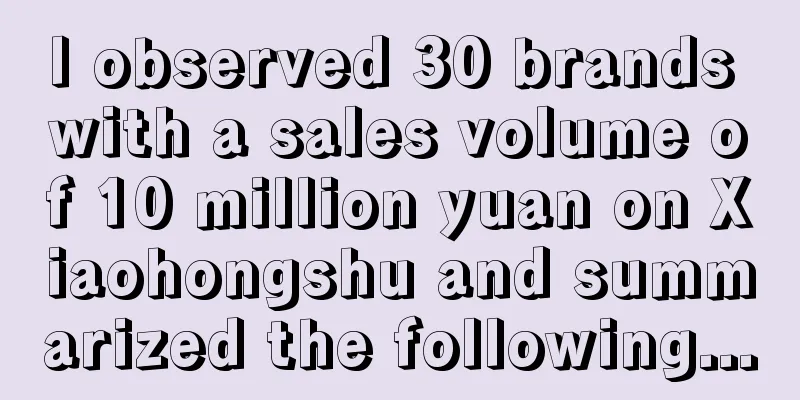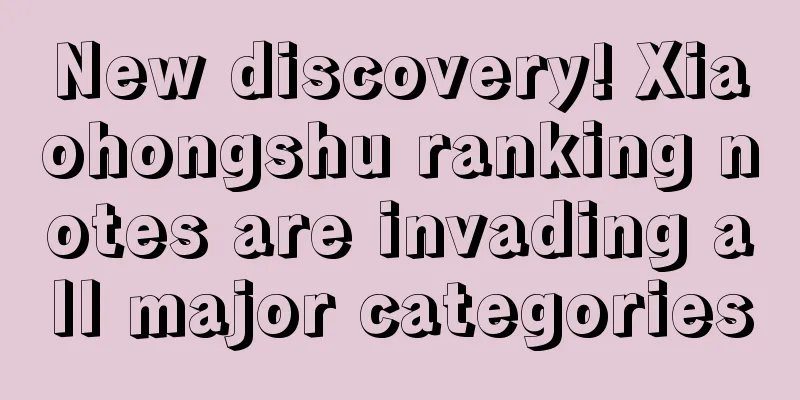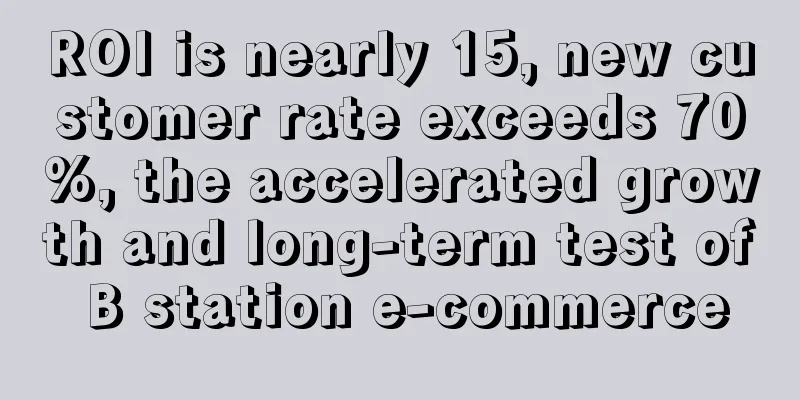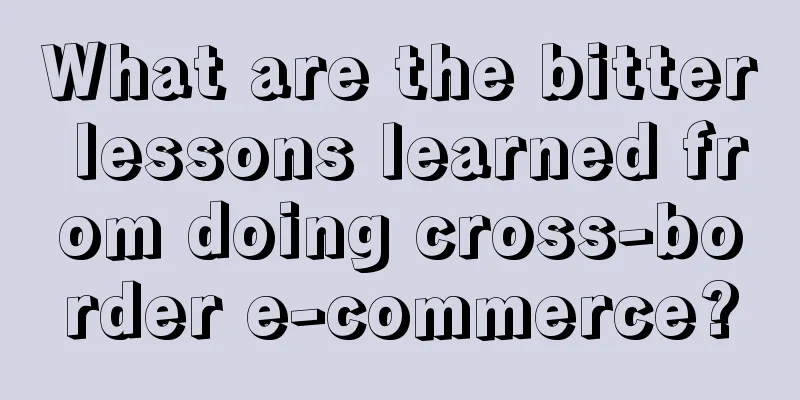I observed 30 brands with a sales volume of 10 million yuan on Xiaohongshu and summarized the following...

I have observed more than 30 brands that have emerged on Xiaohongshu, analyzed their products and popular content, and concluded that it is essentially a H2H marketing model. Only by focusing on human experience can we provide products and content that meet the needs of the crowd and continuously generate differentiation. Recently, I have been communicating with brand CEOs. Is there anything that cannot be copied by peers? Yes! That is to favor the right people and continuously optimize the experience of customers and consumers. It may seem a bit old-fashioned, but it is actually effective. Next, let’s take a look at the impact of the H2H marketing model on businesses and brands. Only 30% of people can understand it, so I suggest you share it with your friends for discussion. This article mainly analyzes the following points:
1. The company’s core soft power is hard to imitate by Xiaohongshu’s peersFirst of all, from the perspective of competition among similar brands, what are the impacts? Your business competitors, with their one-way understanding of the crowd, will find that we are more differentiated from the perspective of communication and operation. In a short period of time, competitors cannot identify the reasons behind the actions. They can only guess at the surface at every node and cannot understand the source of the action. For companies and brands that understand this gameplay, their starting point, or the entire core, is actually centered around the experience of new groups of people. When our competitors want to compete with us, they may only see our local actions, but we have endless and more marketing methods, whether it is communication or packaging, you will find that our so-called marketing differentiation is more obvious. When a brand innovates, more competitors will try to imitate it without understanding that what it is doing is the most original thing. I think this may be the first point, based on marketing to the crowd or people, or the so-called value co-creation, this may be what ordinary companies can see. To put it bluntly, there are more differentiations, or more competitiveness. To add to the definition of H2H marketing: This concept was proposed by my grandfather, who is over 90 years old now.
As an example of H2H people-oriented marketing, Xiaohongshu provides a high-quality platform for brands. Through content shared by real users, brands can better demonstrate their value and advantages and attract the attention and trust of target audiences. 2. With the advent of AI, culture and emotions cannot be replacedWhen AI appears, the way of data dissemination may be copied, but there is one thing that cannot be replaced, that is, human marketing is emotional, and people's understanding of culture is different. If AI becomes more popular in the next few years and every company is using AI, then it can copy a lot of things and form a lot of templated content. But if our company is based on H2H marketing, we will find that human emotions, human stories, and human mental journeys cannot be quickly imitated or copied. Just like many foreign brands, such as Starbucks, Apple, etc., they pay more attention to the dissemination of brand culture and concepts. This cannot be explained in just one or two sentences, but requires long-term and firm dissemination of these cultures. Therefore, when AI comes and we adopt the H2H marketing model, we will find that each brand has a different style. Only from this perspective can Chinese brands flourish. Simple copying will not succeed, and many brands or companies have a short lifespan. Only with this understanding can the brand's lifespan be longer and the cycle longer. Therefore, whether it is our competitors or ourselves, when we are communicating, if we only consider a large amount of content that users do not want, even if we push this content in front of them, they will not feel anything. 3. New categories that can generate larger marketsBased on H2H marketing, we will find that many categories have been extended. For example, I also write articles and books, and I am also an official mentor of Xiaohongshu. I often give lectures to companies. In the process of contacting many brands and merchants and making products myself, I know that I need to gain insights into segmented groups and understand their ideas. From this perspective, we will find that many categories are constantly expanding because the new group of people have a different perception of brands than those born in the 1980s and 1990s. Why is this? The channels through which new groups of people are exposed to information vary. There are always some new brands that will identify new channels, such as Xiaohongshu, to create brands that are more recognized by this group of people. These brands are often what they see at first glance, but those born in the 1980s may use other platforms more often, or some media communications in the past may be more likely to give birth to new categories. For example, we often talk about wet toilet paper, new products for pregnancy gifts, etc. These new categories did not exist in the past. I firmly believe that in the next 2, 5, and 10 years, there will be more subdivided categories based on H2H crowd insights, crowd understanding, or people-oriented marketing, and this will also be the direction of the future. Therefore, if companies can understand this core, their lifespan may be longer, rather than just engaging in price wars in China or relying solely on communication efficiency to allow new segmented brands to be born in categories or among the population. 4. Quickly enter Xiaohongshu with low cost to achieve faster successWhen I was managing my own projects or explaining the communication in niche areas of Xiaohongshu to big brands, I found that only by basing on people's experience, communicating with them in depth, and understanding their joys and sorrows, can we come up with completely different communication templates. For example, in the BeBebuS baby stroller case that I often mention during offline lectures, companies may understand this case from their own perspective, or believe that their communication should start from five major perspectives, as well as how to highlight users and selling points. But in fact, when you communicate in depth with the crowd or with kols, you will find that the ideas will be different. For example, when communicating with kols, they represent the opinions and ideas of a part of users, and you will find that the perspective of communication is completely different, including the scenarios and selling points of communication, which may not be what users need. Therefore, whether it is our competitors or ourselves, when we are doing dissemination, if we only consider disseminating a large amount of content that users do not want, even if we push this content in front of them, they will not feel anything. Only based on H2H marketing can we have greater help in the innovation of this product category, the innovation of our communication, and the development of new categories. So, how is H2H marketing different from marketing in the past? I analyzed it from the following two perspectives. 5. What is the difference between Xiaohongshu’s H2H model and the past?What is the difference between Xiaohongshu's H2H model and the past? Are B2B and B2C models a thing of the past? In fact, the key lies in how we use it comprehensively, or how we understand this model. The characteristic of H2H is that it is people-oriented and adds its own experience and feelings to the process of fission and dissemination. We can analyze it from two parts: From the perspective of communication, B2B is to find advertisers for communication or help us to carry out large-scale communication in the next step, and its purpose is communication. For example, when a product is launched for marketing, we may need to find some large media parties to let them speak for us or reprint it, which is a more specific consideration. From the perspective of B2C communication, when a company or brand is communicating, it hopes that the users around it can receive the information, but it still takes a condescending attitude and stands completely from the perspective of the company or brand. In other words, the company has funds and wants to advertise to reach these people. From a communication perspective, H2H may be suitable for this new communication marketing model. Another way to understand it is how users understand all the products in their hands and whether they conform to the communication angle we want. Taking the maternal and infant industry, cultural tourism industry or the big health industry as an example, every user, consumer, even tourist and traveler can reversely shape and disseminate the selling points of the product based on their own understanding. Many selling points may not be what kind of information our consumers or brands think they should give them, but rather they are co-created with businesses from the perspective of consumers and users. This is the biggest difference we can see. From a business perspective, from a B2B perspective, when a product, brand or content reaches users, we need to find some big brands to help us spread it. The same is true from an H2H perspective. If users want to support, like and recognize you, then they must participate in producing content to impress the people around them. Therefore, the second and third points of H2H are about value co-creation, so that people can form a communication that they like. Whether it is selling points, brands, communication and other output content, the product is enough to impress this part of the population and make them willing to become communicators. In this way, it may be very different from the marketing methods of the past. I think B2B and B2C are not a thing of the past, but can be combined with the current H2H, just need to be used according to different scenarios and situations. Final summary: Imagine that in this era of information explosion, AI and data are flooding in like a tide, but what can truly touch people's hearts and make people remember are often those stories that are full of warmth and emotion. The H2H model captures this point, making the brand no longer a high-handed advertising machine, but a friend who can listen to and resonate with consumers. This transformation makes the brand story more vivid and the consumer experience more profound. New groups, new demands, new channels... all of these provide a constant source of inspiration for brand innovation. Wet toilet paper, new products for pregnancy gifts... these categories that may have been unheard of in the past have now become popular in the market. Behind this is the result of the H2H model's deep insight into the population. Traditional marketing models such as B2B and B2C are not outdated, but they need to be combined with the H2H model. Because no matter how the times change , human needs are always the core of marketing. Author: Zhuang Jun Source: WeChat public account "Zhuang Jun (ID: zhuangjunweixin)" |
<<: Xiaohongshu, the most suitable platform for Chinese lululemon from 0 to 1
>>: A formal way to quickly increase sales on Xiaohongshu
Recommend
How does Amazon chat with sellers? How?
The difference between Amazon and Taobao in China ...
In addition to ABtest, there are better testing methods!
Do you ever feel stressed when facing the business...
Brand No. 1: Double 11 promotion, four levels and three characteristics
The Double 11 shopping season has begun to warm up...
Brand-made skits are more effective than product placement
As an emerging content marketing method, brand-mad...
Crisis management is not limited to public relations, nor is it just about dealing with the 315 broadcast.
Crisis management is a systematic project in the d...
With the logic of hot selling and affordable price, Kudi fills the gap in the demand for coffee among the people.
In an era when affordable coffee has become a rigi...
Question Lei Jun, understand Lei Jun, and become Lei Jun
Lei Jun's fans on Douyin have skyrocketed, cre...
What preparations should be made to build an independent website? What do you need to prepare?
When merchants build cross-border independent webs...
The effect of traffic is overestimated
The change in the mechanism of public accounts has...
Why is there no traffic even though Shopee insists on launching new products? What else needs to be done?
In the process of opening a Shopee store, many mer...
How to set up exclusive discounts for Amazon members? What are the discount rules for Amazon Prime members?
Amazon Prime membership program is one of the impo...
Will the cancellation of Shopee's business license affect the store? How to operate Shopee?
If sellers want to develop the Southeast Asian mar...
Detailed and comprehensive: Data analyst growth strategy
Data analysts often face multiple challenges in th...
After scouring the market for 3 months, I found 4 ways out for owners of maternity and baby stores!
This article describes what you should do in order...
Can Shopee deliver goods to customers by itself? How to deliver goods?
To conduct cross-border e-commerce business on the...









